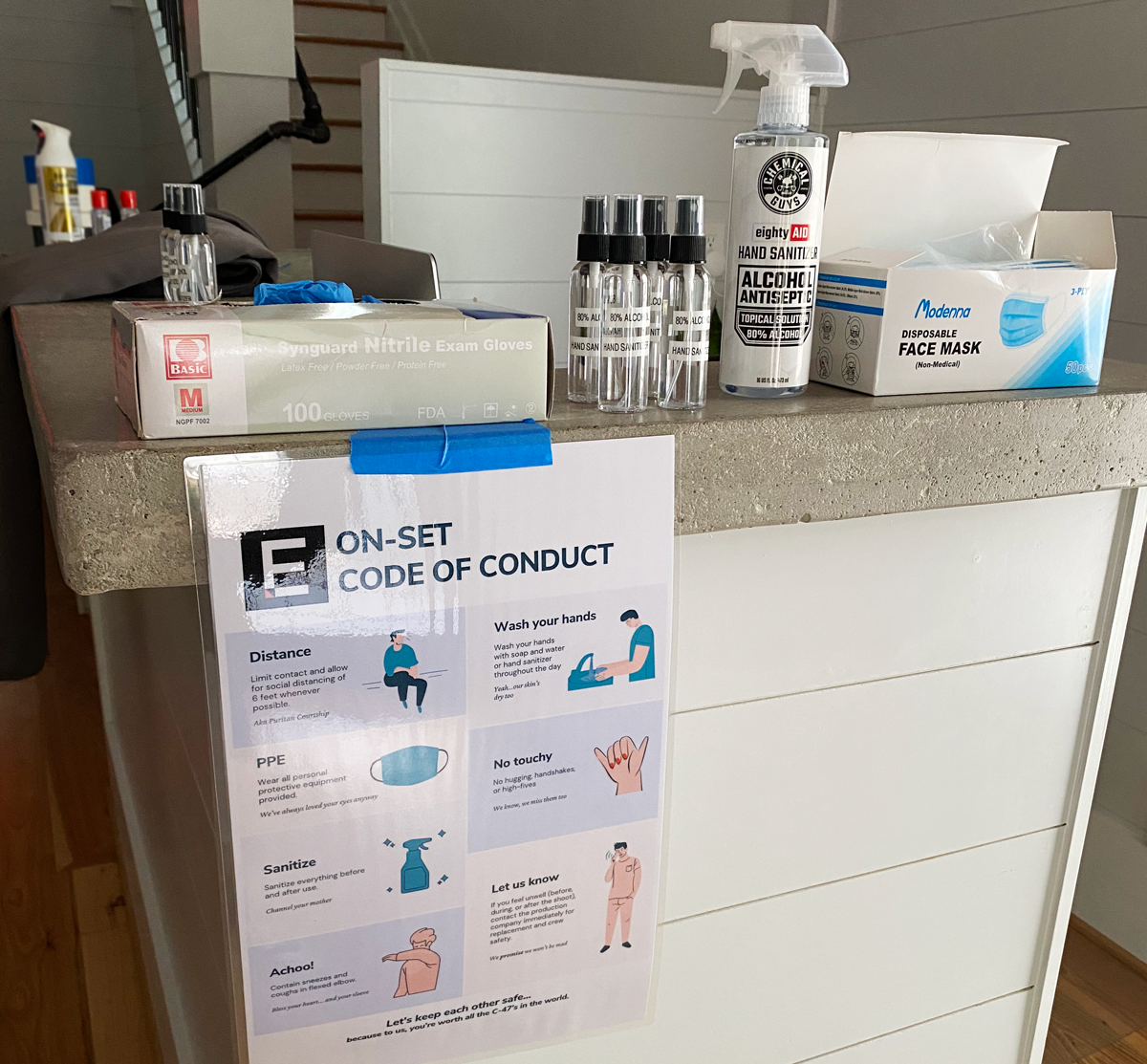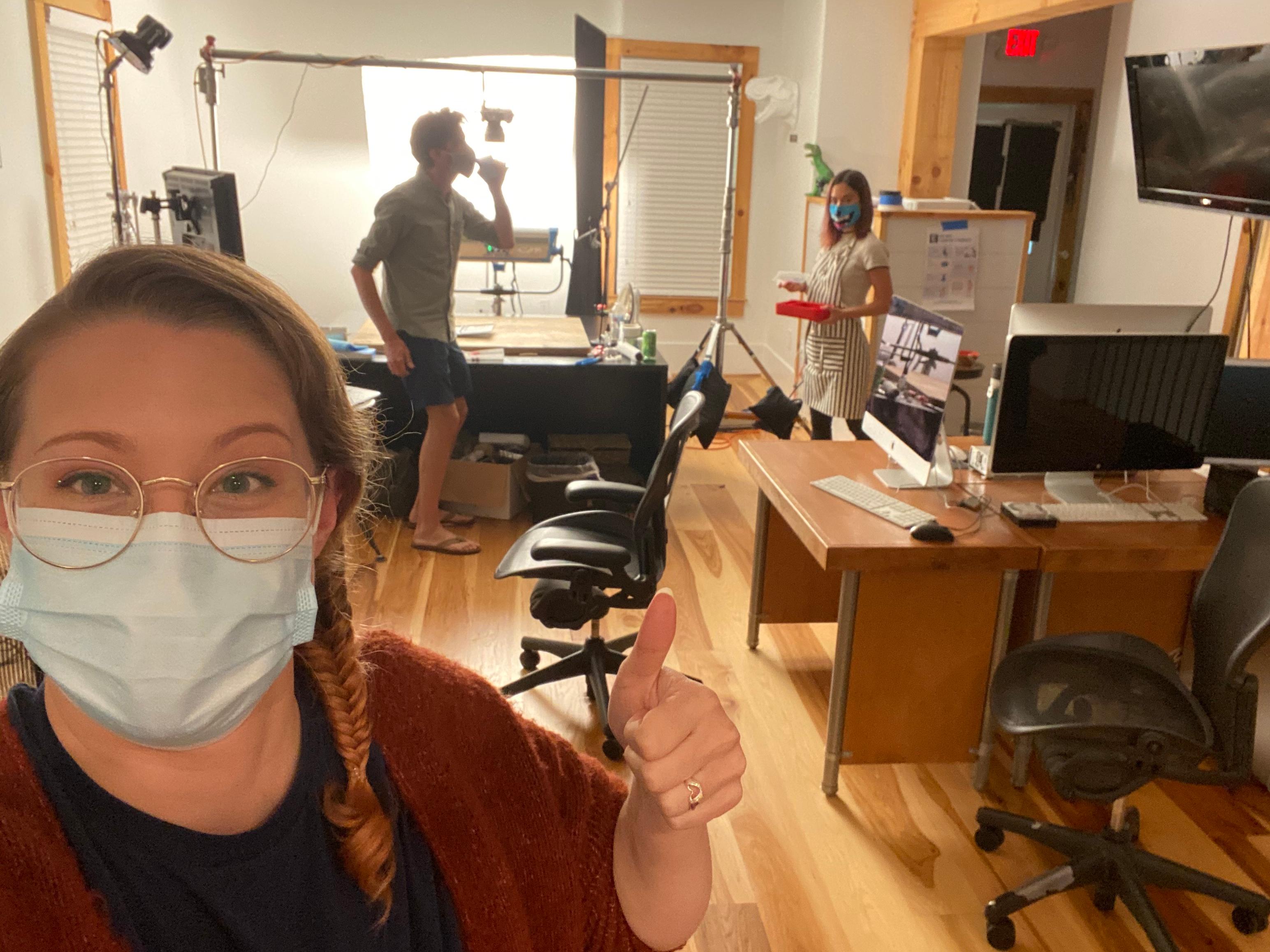
Lights, Camera, COVID Safety Checks... Action!

Written by Steph Carson
No one can deny that we’re seeing some great innovations in the way of live action shooting during this Covid-era. It’s my opinion that many of the safety protocols, scaled back crews, and remote supervision will become a regular aspect to shooting even in the “post-Covid” world. As they say, necessity is the mother of invention.
Started From Quarantine and Now We’re Here
The term “scrappy” is one we’ve heard many times over the years. I’ve seen the term go from a positive selling-device to imply a less expensive and more flexible style, to being an industry “no-no” which instills feelings of a less-than-top-tier product and experience.
It’s an understatement to say that COVID-19 has changed (and challenged) a lot of business norms. It’s proven that productivity does not have to be synonymous with being in an office (NOT in joggers) from 9-6, bloating a production budget simply for the sake of a “dog and pony show” or possibly even attending that live-action shoot when you can just as easily participate from a more productive environment. Sure, you may not get to enjoy the guilty pleasure of craft services and someone constantly reminding you of your obvious shortcomings in keeping yourself hydrated... but you can hop on other calls as needed without having to ask where a good spot is, trust in your internet connection and of course… wear joggers.
With all of that in mind, I’m seeing “scrappy” making a comeback in a whole new way, albeit with a technological makeover.


Using Technology to Our Advantage
So let’s talk about remote shooting and some of the positives and the potential pitfalls to look out for. Recently, Elevation hosted a 3-day live-action stop motion food art shoot. The crew was 6-people strong, we shot at the Elevation office in order to better control the environment and most interestingly, neither the client nor the lead Creative Director were present.
To do this, we had two cameras set up in the space and feeding through a Zoom call. The first was a direct monitor feed (our virtual video village, as it were), showing the actual shots being captured. The second was a wider feed of the room, provided by a camera mounted on a gimbal. This is where it gets fun. We worked with a technology provider, which allowed our ECD to actually control the camera (pan, tilt, zoom, etc.)
With these two feeds, not only could the client see everything going on, but our ECD could direct and give input from home.
Balancing Virtual Feedback – Our First Experience
With the tech challenge conquered, now we had to figure out how to balance virtual feedback. Anyone who’s attended a stop-motion shoot knows it’s about as exciting as watching paint dry. However, feedback during a stop motion shoot is not as stress-free as that. A note half-way through the shoot could mean hours of set-backs. Luckily, our client on this particular project has been through this sort of shoot before with us and completely understood the repercussions and process (so thankful for her!)
What made this experience different, is that supplying our client with a link to the feed, meant that her clients and the rest of her team could watch live as well. In a typical shoot situation, the attending clients can act as a gatekeeper and funnel any notes and input coming in. This streamlines the process and eliminates any cross-notes going to the production team. With entities as large as our particular client on this project, there can sometimes be at least 5 levels of departments and sub-clients to please that may have differing opinions on any given detail. It’s key to have a single point person and decision maker on the client-side filtering that feedback.
Supplying that Zoom link felt like opening Pandora’s box. A proverbial “bead-of-sweat” formed on my forehead as I sent it.
As the producer of this project, my days on set looked like the following:
- ECD, Slacking comments sidebar so as to not to clog up the Zoom communication channel with internal tweaking and minutia
- Direct client texting sidebar for similar reasons and quick answers while snapping phone images in the kitchen of product being assembled before safely transported on set
- The rest of my client’s clients, their agency, and my client’s team all commenting their opinions and notes on Zoom chat
- Relaying ALL of that information and general direction on set to crew
- Ensuring new COVID-related considerations were being handled on set (Have the surfaces been wiped? Have the trash cans been emptied this hour? Is the hand sanitizer still in ready supply? And so on)
- Being a producer in all the traditional senses: time-keeping, shot list checking, post-production-perspective supervision (making sure we have enough clean shot plates and materials in order to handle any potential surprises in post)
It was a lot to juggle, but it was also a great learning experience to think about future streamlining solutions in order to filter all the feedback. It was a great exercise in bringing people together in the spirit of contribution.
How to Manage Virtual Feedback During a Shoot
My recommendation for anyone about to tackle a similar experience (and for my future self), would instead be to create a protocol for a point-person. This pre-designated person (likely the direct client) would have the only ability to “raise their hand” in a Zoom chat to convey consolidated feedback. In order to obtain that consolidated feedback, a side-shared Google Excel could easily mitigate the confusions of “who’s weighed in” for them.
By making a list of all inputting parties with a field for notes on a particular scene and a simple check box (to track who’s has sign-off), accompanied with a cutoff time for input (for the sake of shoot schedules), the client can feel confident that they have all the information to make a final call and relay that single/corroborated message to the production arm. This also deflects a bit of the responsibility back to the parties “Zoom’ing in” to stay on track of their window for input and as a result, weigh in when we they feel strongly about something, versus just weighing in simply because they have been given an opportunity to (Luckily, I never personally encountered this on my shoot, as everyone involved was incredibly respectful of the process and were overall conservative with their feedback). This client-maintained spreadsheet and point-person procedure would also eliminate any potential pitfalls in post-production, being able to easily track backwards to why certain decisions were made.
Lessons to Keep Around Post-COVID
This may all sound like a lot of work and shoots, as we all know, already involve a sometimes overwhelming amount of pre-production planning. So why in the world would I hope that this trend (of course, once streamlined) is something that continues post-COVID? Easy answer – because the upside of all of this is a more seamless post-production process.
For this particular project, post-work is already underway and I have already been able to anticipate and solve for notes that I know may be points of contention. For example, because I knew on set that one team was unsure about whether they “liked the purple napkin in the shot or not”, I was able to have the DP capture all the materials needed for us to easily remove it and send two samples during the first rough review. This tiny detail may have saved us a week or more of feedback time and back and forth on side chains before we found out about it.
So what’s my final takeaway? Let’s all continue to redefine (and refine) “scrappiness,” work smart, find the positives in any situation, and figure out what solutions are out there. These are the best opportunities to grow and put our thinking caps on, share ideas and advice with one another, and most of all, roll with it. We’ll get there together.
… ps. Joggers.
Topics: production


